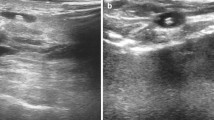Abstract
Background
Wire localization is currently the most widely used localization strategy for excision of nonpalpable breast lesions. Its disadvantages include patient discomfort, wire-related complications such as wire displacement/fracture, and operating room delays related to difficulties during wire placement. We have implemented the technique of intraoperative ultrasound-guided excision using hydrogel-encapsulated (HydroMARK) biopsy clips for lesion localization. We hypothesize that this method is as effective as wire localization for breast conserving therapy.
Methods
This is a retrospective review of 220 consecutive patients who underwent segmental mastectomy or excisional biopsy using wire localization or hydrogel-encapsulated clip localization from January 2014 to July 2015. Data were collected and analyzed. Statistical analyses for differences between groups were performed using t tests and Mann-Whitney rank-sum analyses.
Results
A total of 107 excisions were performed using hydrogel-encapsulated clip localization, and 113 excisions were performed using the traditional wire localization technique; 68 % of our patients underwent excision for malignant pathology. Wire placement took a mean of 46 minutes (range 20–180 min), compared with 5 minutes for ultrasound localization (p < .001). Successful intraoperative ultrasound localization and excision was performed on 100 % of patients. There was no difference in re-excision rates for positive margins or overall specimen size between the two groups.
Conclusions
Intraoperative ultrasound-guided excision of nonpalpable breast lesions using a hydrogel-encapsulated biopsy clip for breast conserving therapy is a safe and feasible alternative to the traditional preoperative wire localized excision. This technique will lead to improvement in patient experience, operative efficiency, and alleviate wire-related complications.


Similar content being viewed by others
References
Ahmed M. Radioactive seed localization for non-palpable breast cancer. Br J Surg. 2013;100:1253 (Br J Surg. 2013;100:582–8).
Volders JH, Haloua MH, Krekel NM, Meijer S, van den Tol PM. Current status of ultrasound-guided surgery in the treatment of breast cancer. World J Clin Oncol. 2016;7:44–53.
Ahmed M, Douek M. Intra-operative ultrasound versus wire-guided localization in the surgical management of non-palpable breast cancers: systematic review and meta-analysis. Breast Cancer Res Treat. 2013;140:435–46.
Chan BK, Wiseberg-Firtell JA, Jois RH, Jensen K, Audisio RA. Localization techniques for guided surgical excision of non-palpable breast lesions. Cochrane Database Syst Rev. 2015;12:CD009206.
Jakub JW, Gray RJ, Degnim AC, Boughey JC, Gardner M, Cox CE. Current status of radioactive seed for localization of non palpable breast lesions. Am J Surg. 2010;199:522–8.
Thompson M, Henry-Tillman R, Margulies A, et al. Hematoma-directed ultrasound-guided (HUG) breast lumpectomy. Ann Surg Oncol. 2007;14:148–56.
Pinkney DM, Shah BA. Prospective comparative study to evaluate the sonographic visibility of five commercially available breast biopsy markers. J Diagn Med Sonogr. 2013;29:151–8.
Lefor AT, Numann PJ, Levinsohn EM. Needle localization of occult breast lesions. Am J Surg. 1984;148:270–4.
Klein RL, Mook JA, Euhus DM, Rao R, Wynn RT, Eastman AB, Leitch AM. Evaluation of a hydrogel based breast biopsy marker (HydroMARK(R)) as an alternative to wire and radioactive seed localization for non-palpable breast lesions. J Surg Oncol. 2012;105:591–4.
Ahmed M. The need for randomized controlled trials to evaluate radioguided occult lesion localization (ROLL) for breast cancer. J Surg Oncol. 2013;107:873.
Aydogan F, Mallory MA, Tukenmez M, et al. A low cost training phantom model for radio-guided localization techniques in occult breast lesions. J Surg Oncol. 2015;112:449–51.
Gray RJ, Pockaj BA, Karstaedt PJ, Roarke MC. Radioactive seed localization of nonpalpable breast lesions is better than wire localization. Am J Surg. 2004;188:377–80.
Pouw B, de Wit-van der Veen LJ, Stokkel MP, Loo CE, Vrancken Peeters MJ, Valdes Olmos RA. Heading toward radioactive seed localization in non-palpable breast cancer surgery? A meta-analysis. J Surg Oncol. 2015;111:185–91.
Ngo C, Pollet AG, Laperrelle J, et al. Intraoperative ultrasound localization of nonpalpable breast cancers. Ann Surg Oncol. 2007;14:2485–9.
Arentz C, Baxter K, Boneti C, Henry-Tillman R, Westbrook K, Korourian S, Klimberg VS. Ten-year experience with hematoma-directed ultrasound-guided (HUG) breast lumpectomy. Ann Surg Oncol. 2010;17 Suppl 3:378–83.
Larrieux G, Cupp JA, Liao J, Scott-Conner CE, Weigel RJ. Effect of introducing hematoma ultrasound-guided lumpectomy in a surgical practice. J Am Coll Surg. 2012;215:237–43.
Blumencranz PW, Ellis D, Barlowe K. Use of hydrogel breast biopsy tissue markers reduces the need for wire localization. Ann Surg Oncol. 2014;21:3273–7.
Eggemann H, Costa SD, Ignatov A. Ultrasound-guided versus wire-guided breast-conserving surgery for nonpalpable breast cancer. Clin Breast Cancer. 2016;16:e1–6.
19. Gittleman MA. Single-step ultrasound localization of breast lesions and lumpectomy procedure. Am J Surg. 2003;186:386–90.
20. James TA, Harlow S, Sheehey-Jones J, et al. Intraoperative ultrasound versus mammographic needle localization for ductal carcinoma in situ. Ann Surg Oncol. 2009;16:1164–9.
21. Klimberg VS. Intraoperative image-guided breast-conservation surgery should be the gold standard. Ann Surg Oncol. 2016;23:4–5.
Authors contribution
LFG contributed to the collecting and analysis of data and interpretation, conception, design, composition, drafting, and editing of the manuscript. AH contributed to data collection and editing of the manuscript. CMS contributed to conception, design, participated in procedures, and to the editing of the manuscript. AB contributed to IRB submission and approval process. EV contributed to the conception, design, and editing of the manuscript. JM contributed to the conception, design, and manuscript editing. LRPS contributed to the conception and design of the manuscript, data analysis and interpretation, and the composition/editing/writing of the manuscript.
Disclosures
None of the authors have disclosed any conflict of interest
Author information
Authors and Affiliations
Corresponding author
Rights and permissions
About this article
Cite this article
Gentile, L.F., Himmler, A., Shaw, C.M. et al. Ultrasound-Guided Segmental Mastectomy and Excisional Biopsy Using Hydrogel-Encapsulated Clip Localization as an Alternative to Wire Localization. Ann Surg Oncol 23, 3284–3289 (2016). https://doi.org/10.1245/s10434-016-5325-x
Received:
Published:
Issue Date:
DOI: https://doi.org/10.1245/s10434-016-5325-x




